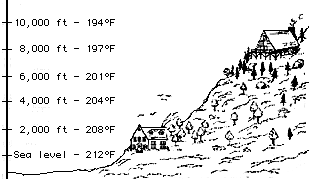Peter Piper picked a peck of pickled peppers;
A peck of pickled peppers Peter Piper picked;
If Peter Piper picked a peck of pickled peppers,
Where's the peck of pickled peppers Peter Piper picked?
A peck of pickled peppers Peter Piper picked;
If Peter Piper picked a peck of pickled peppers,
Where's the peck of pickled peppers Peter Piper picked?
Who is Peter Piper? Why, he’s a fellow named Peter who blows a pipe and picks peppers . . . duh!
But more importantly, what in the heck is a peck?? A peck is a measurement unit of dry measure . . . it is equal to 2 gallons or 8 dry quarts or 16 dry pints. That’s a lot of peppers! But it doesn’t turn out to be a whole peck . . . er . . . heck of a lot when you pickle them.
If you’ve gotten a garden and your peppers are popping you should want a way to preserve them. There are a number of different ways to do this. Last year I dried most of my peppers with excellent results . . . I’m still using them in any number of recipes calling for pepper flakes.
But, this year I decided to try something different . . . taking a cue from Peter Piper I opted to pickle and can them.
To Make Homemade Pickled Peppers you can use just about any kind of pepper . . . hot or sweet . . . including Chilies, Pimiento, Hungarian, Banana, Jalapeno, Etc.
If stored properly, canned pickled peppers have a shelf life of about 12 months. That is they should be kept in a cool, dark place
For 9 pints you will need about 7 lbs of peppers total. You can mix and match varieties, hot and sweet . . . whatever you want.
You will also need:
Jar grabber (to pick up the hot jars)
Jar funnel
Large spoons and ladles
At least 1 large pot
One 6 - 8 quart pot or saucepan
Pint Sized Ball jars
1 Canner or a huge pot
It’s very important that you select peppers that are very fresh and crisp. Limp, old peppers will make nasty tasting canned peppers.
Hot pepper caution: Wear plastic or rubber gloves and do not touch your face while handling or cutting hot peppers. If you do not wear gloves, wash hands thoroughly with soap and water before touching your face or eyes . . . or your private parts. Ouchie!!
Wash the jars and lids. The dishwasher is fine for the jars. I put the lids in a small pot of almost boiling water for 5 minutes, and use the magnetic "lid lifter wand to pull them out.
Get a large pot of water boiling. This is for the hot water bath that you will be processing the peppers in.
Wash the peppers to remove any dirt and debris. You can remove the seeds if you want to, at this point. I like to keep my hot peppers whole for the fullest heat.
Blister the peppers by placing them in a hot oven set at 400º for 6 to 8 minutes; using tongs carefully turn pepper often until skin blisters evenly on all sides. Then place them in a bowl covered with a towel until you’re ready to use them.
Next you want to prepare your pickling solution. In a saucepan, combine and heat:
5 cups vinegar (5%)
1 cup water
4 tsp canning or pickling salt
2 tbsp sugar
2 cloves garlic
Heat it to boiling and simmer for 10 minutes. Then remove the garlic (and discard).
Pack the jars with the pickles and pour the vinegar solution into each packed jar. Fill jars, leaving 1/2-inch of headspace. Flatten whole peppers. You may add 1/2 teaspoon of salt to each pint jar, if desired for taste (it is not a preservative).
Put the lids on each jar and seal them by putting a ring on and screwing it down snugly (but not with all your might, just "snug").
Put the jars in the canner and keep them covered with at least 1 inch of water. Keep the water boiling. Boil them for 10 minutes. Remember to adjust for altitudes . . .
The normal boiling point of water at sea level is 212°. At higher altitudes, water boils at lower temperatures. When processing jars of jams, pickles, and other preserves in a boiling water bath at higher altitudes, use the following chart to adjust times.
1,001 feet to 3,000 feet, add 5 minutes to processing times.
3,001 feet to 6,000 feet, add 10 minutes to processing times.
6,001 feet to 8,000 feet, add 15 minutes to processing times.
8,001 feet to 10,000 feet, add 20 minutes to processing times.
3,001 feet to 6,000 feet, add 10 minutes to processing times.
6,001 feet to 8,000 feet, add 15 minutes to processing times.
8,001 feet to 10,000 feet, add 20 minutes to processing times.
Lift the jars out of the water and let them cool on a wooden cutting board or a towel, without touching or bumping them in a draft-free place (usually takes overnight), where they won't be bumped. You can then remove the rings if you like. Once the jars are cool, you can check that they are sealed verifying that the lid has been sucked down. Just press in the center, gently, with your finger. If it pops up and down (often making a popping sound), it is not sealed. If you put the jar in the refrigerator right away, you can still use it.










